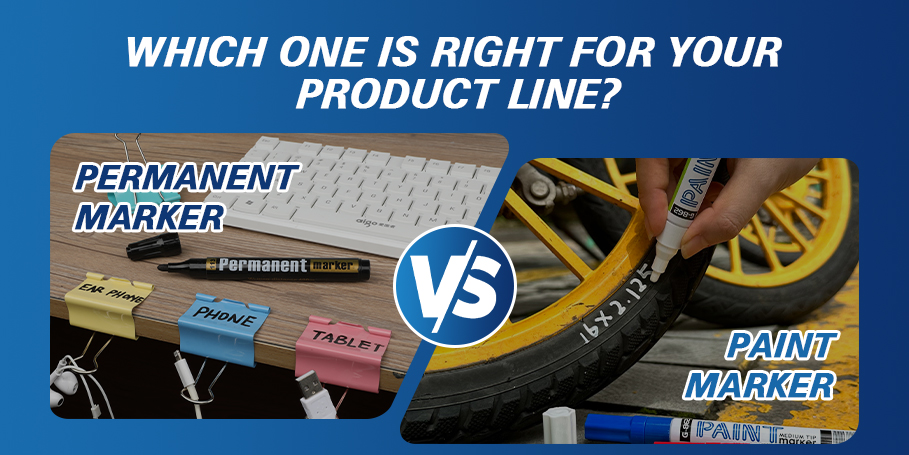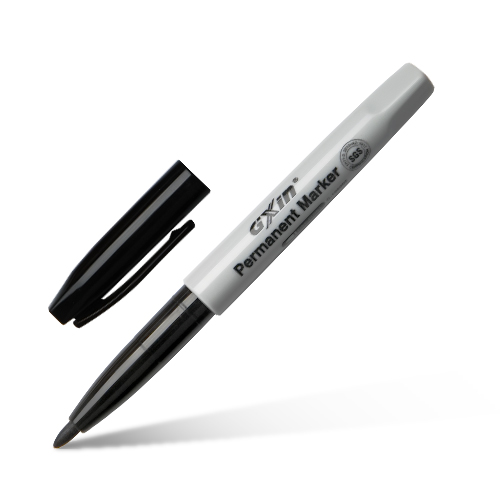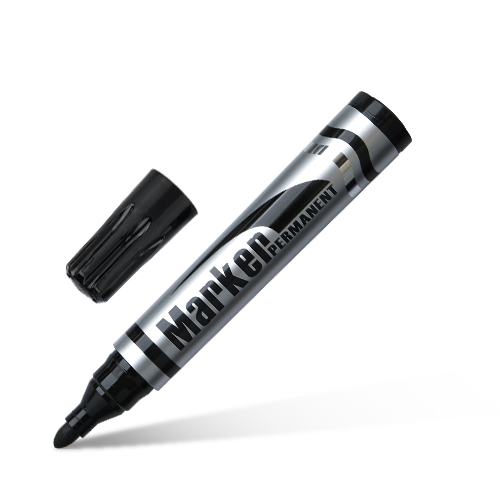
Permanent vs. Paint Markers: Which One Is Right for Your Product Line?
Choosing the wrong type of marker can result in weak adhesion, fading ink, or customer returns—hurting your brand reputation and profits. Here’s how to choose smartly.
Permanent markers and paint markers serve different purposes. Permanent markers are quick-drying and suitable for everyday surfaces, while paint markers are better for rough or dark surfaces requiring vibrant, long-lasting marks.
Both marker types offer benefits, but understanding their differences is essential to choosing the best fit for your market.
What Are Permanent and Paint Markers, and How Do They Work?
Permanent markers use alcohol-based solvent inks containing resins and colorants. These inks penetrate porous or smooth surfaces such as paper, cardboard, plastic, and metal. The ink dries rapidly and resists water, making it suitable for office use, schools, and general labeling. (Wikipedia – Permanent Marker)
Paint markers use thicker, pigment-based inks—typically oil-based—that rest on top of the surface rather than being absorbed. These markers require shaking before use and often contain a valve to control ink flow. The result is highly opaque, UV-resistant, and weatherproof lines ideal for glass, ceramic, rubber, wood, and metal. (Wikipedia – Paint Marker)
Each type can be combined with different whiteboard marker tips—such as bullet or chisel—to adjust writing width and ink flow depending on customer needs.
How Do These Marker Types Perform on Different Surfaces?
Surface compatibility is a major factor when choosing between permanent and paint markers.
Permanent markers are optimized for smooth, clean, and lightly porous surfaces like plastic files, folders, laminated paper, and cardboard. The ink adheres fast and resists smudging, but it can fade when exposed to outdoor environments or oily materials.
Paint markers outperform in harsher or specialized conditions. Their pigment-rich ink adheres to non-porous, rough, or dirty surfaces such as metal beams, tools, piping, glass, and concrete. They maintain color visibility even on dark surfaces and resist abrasion, weather, and chemicals.
This makes paint markers essential for automotive, construction, and manufacturing clients—especially when opacity and permanence matter most.
Which Ink Formula Is Best for Classroom, Office, or Industrial Use?
Your target market determines which marker ink to use:
- Classrooms and offices benefit from permanent markers—especially low-odor versions. They’re affordable, reliable, and dry quickly. Bright colors help with presentations, and bullet tips provide clean lines.
- Industrial environments require paint markers. Warehouses, auto garages, and construction sites need ink that withstands moisture, grease, and heat. Paint markers excel in these demanding situations.
- Creative applications, like crafts or retail display writing, also benefit from paint markers for their boldness on dark surfaces.
For B2B buyers building a product line, offering both options under your own brand delivers flexibility across different industries.
Can You Customize Permanent and Paint Markers for OEM/ODM Orders?
Yes, and customization is where your brand stands out. Gxin offers full OEM/ODM services for both permanent and paint markers.
You can select:
- Ink base: Alcohol-based, oil-based, or water-based (eco-friendly)
- Tip type: Bullet, chisel, fine, or brush tips
- Colors: Standard or Pantone-matched inks
- Body design: Custom logo printing, barrel shape, and packaging
- Certifications: RoHS, EN71, ASTM D-4236 (for global compliance)
- Additional features: Quick-drying, anti-dry-out agents, low odor formulations
Whether you’re building a low-cost stationery brand or a high-performance industrial line, Gxin’s OEM whiteboard marker guide supports your vision from start to finish.
Marker Type Comparison Table
| Feature | Permanent Marker | Paint Marker |
|---|---|---|
| Ink Base | Alcohol-based (solvent) | Oil-based (or water-based alternatives) |
| Drying Speed | Fast (within seconds) | Moderate (30 seconds to 2 minutes) |
| Surface Compatibility | Paper, plastic, smooth surfaces | Glass, metal, rubber, rough or dark areas |
| Opacity on Dark Surfaces | Low | High (excellent for signage, contrast) |
| Outdoor Durability | Moderate | Very high (UV and water-resistant) |
| Odor Level | Medium to high | Higher for oil-based, low for water-based |
| Common Applications | Office work, school, labeling | Industrial use, construction, signage |
Frequently Asked Questions (FAQ)
Q1: Can I use paint markers on a whiteboard?
A: No. Paint markers are not dry-erase and will permanently stain whiteboards. Use dry-erase markers for whiteboard writing.
Q2: What’s the difference between alcohol-based and oil-based inks?
A: Alcohol-based inks dry quickly and are great for general writing. Oil-based inks are more opaque, durable, and suitable for rough or outdoor surfaces.
Q3: Are low-odor options available for permanent markers?
A: Yes. Modified alcohol or water-based solvents reduce smell, making them ideal for schools and enclosed office spaces.
Q4: Can I customize both ink and tip types in one order?
A: Absolutely. Gxin offers full customization of ink formula, tip shape, barrel design, and packaging to fit your OEM needs.
Final Thoughts
Choosing the right marker formula helps you deliver products that meet real-world demands—boosting customer loyalty and brand value.





